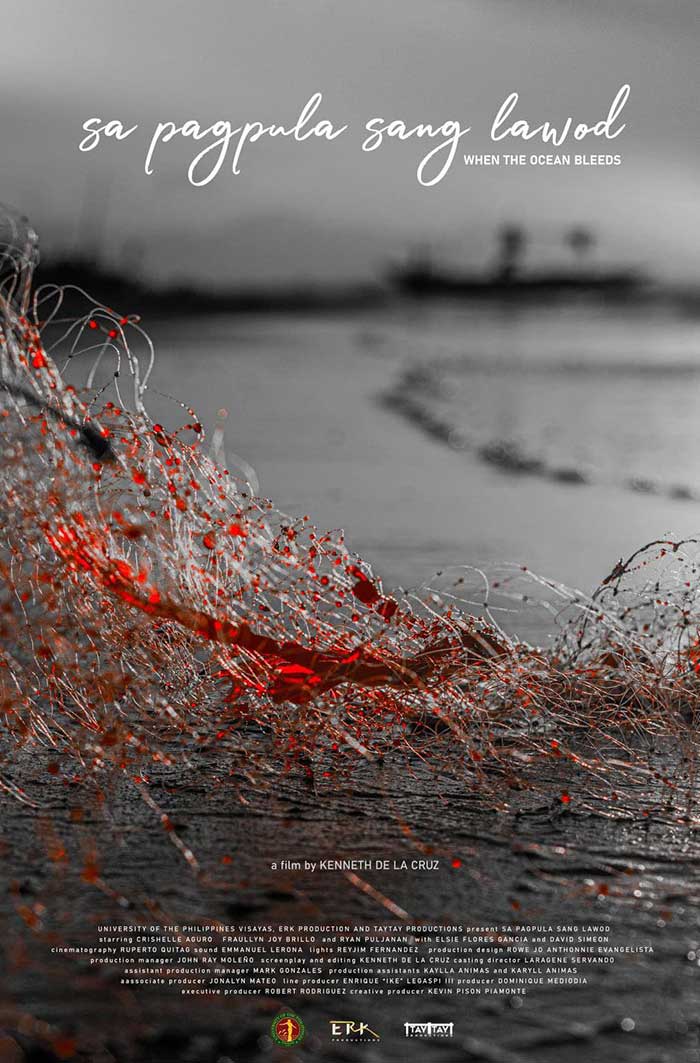
“Sa Pagpula sang Lawod,” the much-awaited film project of ERK productions and Taytay Productions and the University of the Philippines-Visayas renders the plight of the fisherfolk amidst internal and external maelstroms.
Written and directed by Kenneth Dela Cruz with the guidance of Creative Producer Kevin Pison Piamonte, the film slowly builds its narrative by incorporating poetic interludes, montages of the sea, and deep silences that highlight its melancholic imagery. In the middle of this black and white world stands a family of three: Mila, Lito, and Mayla, whose interconnected struggles reveal the undying discourse of “the personal is always political.”
The film unfurls from three different points of view as the characters navigate their lives and ponder on their struggles, while trapped in the crossroads of poverty and the looming threat of Chinese-Filipino maritime conflict.

First comes Mila, a young girl blossoming into womanhood. The film explores her sensuality, her curiosity, then her defiance towards the systems of power that prohibit her from embodying her desires for emancipation. She represents the patriarchal idea of the female body as a site of sin and silence. Her father forbids her from fishing, while her mother disallows her to question tradition and the roles of women in their fishing village. The start of Mila’s menstrual cycle punctuates the recurring appearance of blood in the story.
Ruperto Quitag’s striking cinematography juxtaposes postmodern noir aesthetics and the boldness of the colour red to highlight the many tensions that haunt the narrative. This tension can be felt when her father prohibits Mila to go near the sea, an articulation of a collective fear that a woman’s menstrual blood will drive the fish away. The film connects sensuality with superstition as it follows Mila’s exploration of her blossoming identity within spaces of power that continue to silence her.
Lito on the other hand is portrayed as strong and imposing, but behind the mask of the patriarch is an unverbalised fear and quiet anxiety. Slowly realizing that he is becoming powerless in the face of bigger threats, the film follows the radicalization of his political consciousness and his fight for survival.
The film’s strength does not rely on dialogues, but on the minimalist visual poetry and quiet undertones that intensify the tension of the narrative. Lito’s character development reaches its crescendo as the film eloquently projects his desperation to survive: he finally joins the group of fishermen who would ferry some of the village’s women- now working as prostitutes for economic survival- to the foreign vessels that exploit their seas and threaten their safety.

By dwelling on Lito’s internal conflict as he silently wrestles with his ethical and political convictions, the film positions him as a tragic image of power and powerlessness: here stands someone full of rage and patriotism, slowly fading into the shadows as he realizes the omnipotence of his enemies.
“Our men can’t do anything” laments Mayla, Lito’s wife who sulks in the depth of her silences. Silences haunt the film. It is how the characters deal with traumatic and overwhelming experiences. The looming silence is a manifestation of the oppressive maritime threat that silences and reduces weaker bodies as commodities. The sea and the people living beside it become commodities of this hungry, neo-imperialist force. This tragic realization has crystallized within the village’s collective memory: the women would wait on the shores and sew the fishing nets, the men would ride the waves praying for catch, the women would wait, and the men would return with nothing.
Women’s position of passivity reveal their powerlessness in patriarchal spaces. The narrative reveals that womens’ complicity to structures of power naturalize the tradition of heteropatriarchal binaries and intensify the internalized silence among them. The film ends by leaving a poignant yet vigilant image: husband and wife join hand and hand, a metaphorical epilogue of two bodies uniting, preparing to break away from the oppressive silence and defy a larger body of power.

Following the subjugation and silencing of female characters in the film, a “woman-as-nation” reading is thereby proffered by “Pagpula sang Lawod”. The woman question is always inserted in the discourse of the nation from the “Inang Bayan” narrative of the Katipunan to more contemporary postcolonial feminist projects. While nationalism can be argued as an ideological myth, its presentation in the context of the film follows the trope of imagining the nation as woman.
The narrative elucidates the many interconnections between woman and nation and explores the symbolic connection between women’s personal struggles vis-a-vis the political turmoil that shakes the landscape of the nation. “Pagpula sang Lawod” mirrors the trope of women-as-nation by presenting the lives of Mila, Lito, and Mayla as direct victims of conflicts between larger bodies of power.
Despite their attempt to embody power and exercise agency and autonomy, they are reduced into commodities, objects of desire, and pawns in the territorial dispute between a (passive/feminized) representation of the Philippines under a fascistic leader who undermines the country’s sovereignty for his own political ambitions, and a more (active/masculine) rendering of China and its neo-imperialist forces. The power of the film lies behind its critique of invisible hegemonic forces that perpetually victimize the likes of Mila, Lito, and Mayla and other voiceless entities living within the peripheries.
The notion of essentializing and fetishizing the trope of woman-as-nation remains a challenge that needs to be problematized, expanded, or radicalized, not just by filmmakers but by writers and other cultural producers as well. Liberating the image of a woman’s suffering in the name of nationalism will open new and empowering spaces that do not rely on the cliche romanticization of women’s passivity and subjugation. While the film falls under the presentation of traditional masculine/feminine, conqueror/commodity binaries, it triumphs by revealing its poetics of defiance: the revolutionary message ignited by the fire that binds Lito and Mayla in the end. (John Ray Hontanar/Division of Humanities, UP Visayas)






















